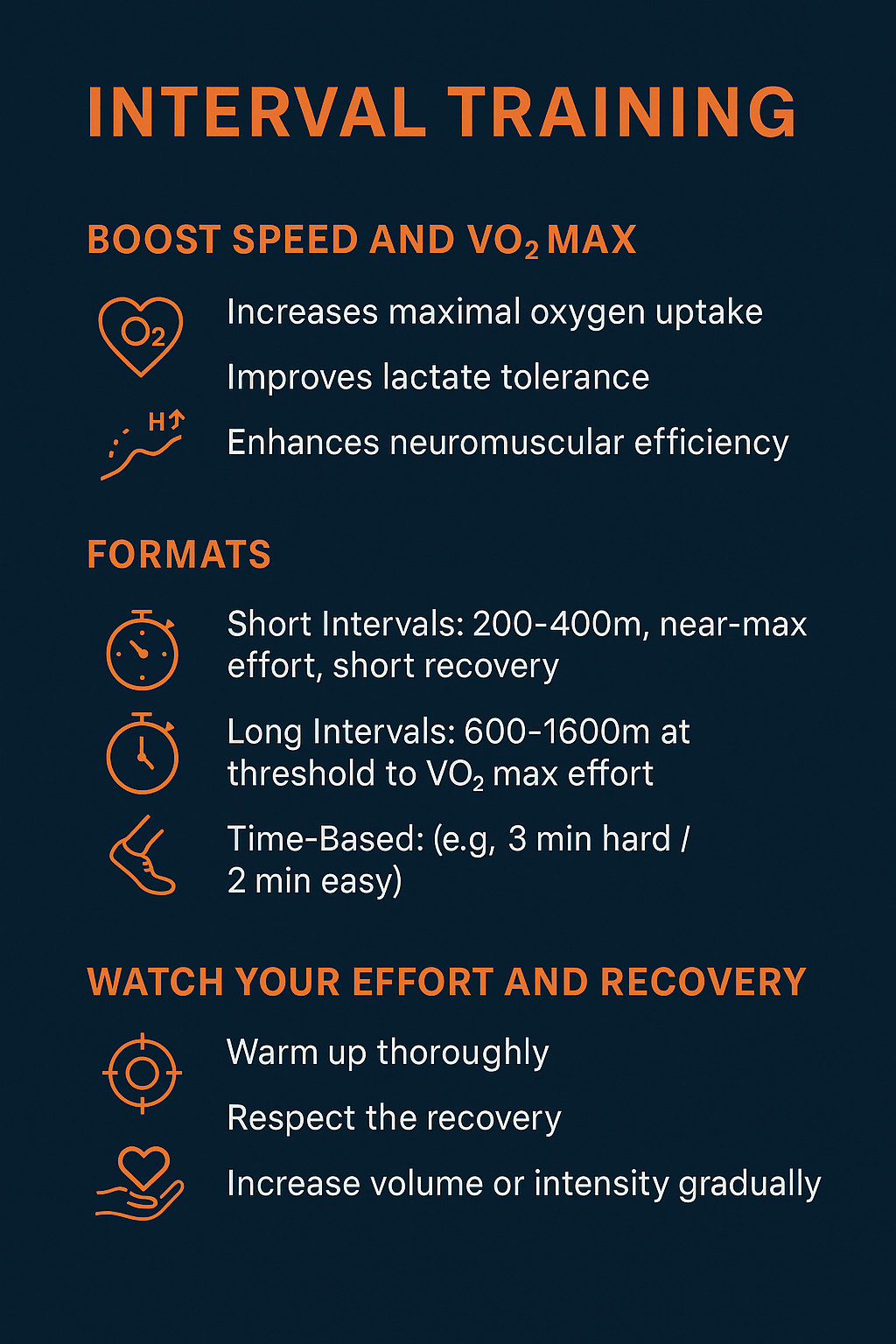Introduction
Speed doesn't come from magic. It comes from specificity, structure, and stress — applied at the right time, in the right way. That's where interval training shines.
Whether you're gunning for a sub-40 10K or building your way toward a 60-minute milestone, interval workouts are one of the most effective ways to improve both top-end speed and aerobic power.
Let's break down what intervals are, why they work, and how to adapt them to your ability and race goals.
What Is Interval Training?
Interval training involves repeated bouts of high-intensity running alternated with recovery periods. Each interval pushes you close to your physiological edge — then backs off just enough to let you repeat the effort.
Common Formats:
- Short Intervals: 200–400m repeats, high intensity, short recovery (30–90s)
- Long Intervals: 600m–1600m or 2–6 minute reps at threshold to VO₂ max effort
- Time-based Intervals: 30s on/30s off, or 3 minutes hard / 2 minutes easy
The intensity is often at or above race pace, targeting VO₂ max, lactate clearance, neuromuscular efficiency, and more.
Why Intervals Work
Boost VO₂ Max
Intervals push you to the edge of your aerobic ceiling — the point at which your body uses the maximum amount of oxygen. Raising your VO₂ max improves your ability to sustain higher efforts longer and recover faster.
Improve Lactate Tolerance
At high intensity, lactate builds up fast. Repeated intervals train your body to:
- Tolerate higher lactate levels
- Clear lactate more efficiently
- Delay the onset of fatigue
This is especially useful for events like the 5K and 10K, where you flirt with that redline the entire race.
Increase Neuromuscular Efficiency
Fast, controlled running improves:
- Stride mechanics
- Leg stiffness and spring
- Turnover and coordination
This efficiency translates directly into economy at race pace.

Understanding the physiological benefits of interval training
Customizing Intervals by Athlete Level
Beginner (e.g. 60+ min 10K runner)
Focus: Building tolerance for faster paces without overreaching
Sample Workout:
- 6 x 400m @ 5K effort, 90s walking recovery
- or
- 6 x 1 min hard / 2 min easy jog
Start with manageable volume and longer recoveries. Emphasize form, not fatigue.
Intermediate (45–55 min 10K runner)
Focus: Improving threshold and building strength at race pace
Sample Workout:
- 5 x 800m @ 10K pace, 2 min jog recovery
- or
- 6 x 3 min @ 5K effort, 90s easy jog
Mix long and short intervals to train both aerobic and anaerobic systems.
Advanced (Sub-40 10K runner)
Focus: Maximal aerobic power, sharpening lactate threshold and mental grit
Sample Workout:
- 8 x 1000m @ 3–5K pace, 75s recovery
- or
- 10 x 400m fast, 60s float jog
At this level, intervals mimic race surges, pace changes, and breakaway readiness.
How to Do Intervals Effectively
Warm Up Well
10–15 minutes of jogging + drills/strides = reduced injury risk and sharper reps.
Run With Purpose
Every interval has a goal: speed, strength, rhythm, etc. Don't just blast through them. Hit your target effort zone.
Respect the Recovery
Jog, don't stop. Recovery is part of the adaptation. If you can't hit your reps, increase rest or reduce reps.
Progress Gradually
Increase volume OR intensity — not both at once. A good rule: increase total work time by 10–15% every couple of weeks.
Finish Feeling Capable
Leave one rep in the tank. The goal is adaptation, not annihilation.
Training Tip
Interval training is the surgical scalpel of your training plan — precise, potent, and transformative. When executed correctly, it doesn't just make you faster. It raises your ceiling, increases your capacity, and trains your mind to push when it counts.
When to Use Interval Training
During Your Training Cycle:
- Base Phase: Light speed work (strides, short reps) to maintain sharpness
- Build Phase: Emphasize VO₂ intervals 1x/week
- Peak Phase: Race-specific intervals (pace practice, surges)
- Taper Phase: Reduce volume, maintain frequency
During Your Week:
Slot intervals midweek, 2–3 days after a long run and 2–3 days before your next big effort.
Final Word
For a beginner, it's about feeling speed for the first time. For the advanced athlete, it's about sharpening the knife.
No matter your pace — this work works.
Key Takeaway
Elevate. Endure. Excel.
Elite You.
